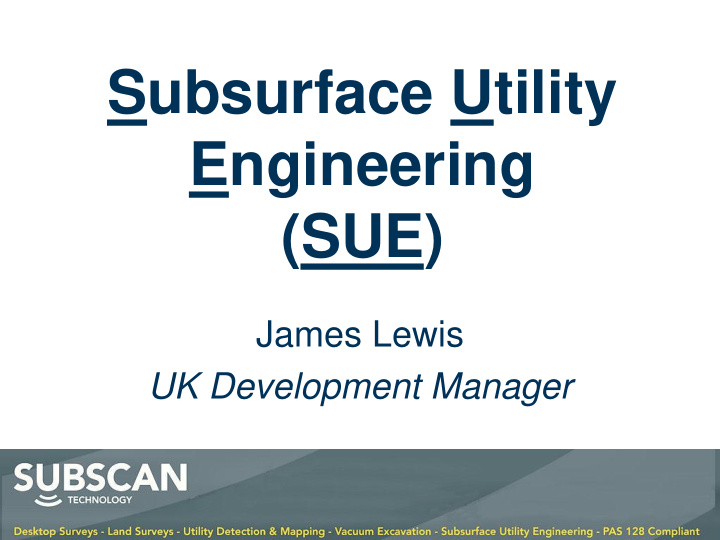



Subsurface Utility Engineering (SUE) James Lewis UK Development Manager
James Lewis 22 Years GPR & Mapping International GPR Support Manager 2 Yrs US Vacuum Excavation 10 Yrs UK Survey Manager Now with Subscan (PAS 128 )
Who are Subscan? Founded in 1992 13 Survey Teams in UK Rugby, Doncaster, Yeovil PAS 128 Drafting Member
? ? Today’s Overview Need for PAS128 What is PAS128 How Does PAS 128 Work Vacuum Excavation Intro The Value of SUE ? Q & A’s
Why Use PAS128? Existing records are often inaccurate/incomplete. UTILITY LOCATION ACCORDING TO STATS RECORD ACTUAL LOCATION OF UTILITY FOUND WITH DESIGNATION (SURVEYED) Risks become extremely difficult to manage.
Why Use SUE? We don’t know where most utilities are !
? ? Why a British Specification What type of Survey? Why such a price spread? What do we expect? ? What do we get?
The formation of PAS 128 Specification for underground utility detection, verification and location Apr 2012 Dec 2012 Jun 2014 • BSI • Second draft • Elections • ICE • First draft complete Symposium • Steering team complete appointed as • PAS 128 • Public • Drafting team • Steering lead Launch Consultation Group review Jun 2012 Jan 2012 Jul 2013
PAS 128 process Defines Provides Defines Quality Sets out scope for Detection Levels for process for Project methods & gathering Deliverables Planning Effort utility data
PAS 128 Quality Levels Desktop Utility Site Detection Verification Record Reconnaissance (QL-B) (QL-A) (QL-C) Search (QL-D)
Quality Level “D” Records Research STATS Compilation As Built Drawings
Quality Level “C” Visible Features Street Furniture Covers Valves Scars
Quality Level “B”
Table 1 – Quality levels of survey outputs (normative) Survey category Quality level designation Post- Positional accuracy Criteria used in the determination of quality level processing (Establish with client prior (Practitioner to determine Horizontal Vertical to survey) post survey) Desktop utility record search QL-D N/A Undefined Undefined Information provided by a utility record search. Site reconnaissance QL-C N/A Undefined Undefined A segment of utility whose positioned is confirmed by visual reference to street furniture, topographical features or evidence of previous road works (reinstatement scar). Detection QL – B4 No Undefined Undefined A utility segment which is suspected to exist but has not been detected and is therefore shown as an assumed route. QL – B4P Yes QL-B3 No ±500 mm Undefined Position of the utility detected by one of the geophysical techniques. (No reliable depth measurement possible) QL-B3P Yes QL-B2 No ±250 mm or ±40% of detected ±40% of detected depth Position and depth of the utility detected by one of the geophysical techniques. 1) depth whichever is greater QL – B2P Yes Position and depth of the utility detected by multiple 2) geophysical QL-B1 No ±150 mm or ±15% of detected ±15% of detected depth depth whichever is greater techniques. QL – B1P Yes Verification QL-A N/A ±25 mm ±35 mm Horizontal and vertical position of the top and/or bottom of the utility. Additional attribution is recorded as specified in 9.2.5 . NOTE Quality and confidence level: D = lowest, A = highest. 1) Electronic depth readings using EML equipment are not normally sufficient to achieve a B2 or higher. 2) Some utilities can only be detected by one of the existing detection techniques . As a consequence, such utilities can not be designated QL-B1.
Method type Minimum equipment Survey grid/search resolution Quality Typical application types to be used levels achievable EML GPR Other techniques A) (passive) General Post- processing M1 Geophysical technique with 5 m orthogonal Use as applicable N/A 5 m survey grid B3, B4 The density of services is typical of no depth estimation transect centres an undeveloped area M2 Passive and active EML and 2 m orthogonal Either: No 2 m survey grid B1, B2, B3, The density of services is typical of a single/multi channel GPR transect centres B4 suburban area or where used to a) 2 m orthogonal; detect utility services crossing a or survey boundary b) high density array M2P Yes M3 Passive and active EML and 1 m orthogonal Either: No 1 m survey grid B1, B2, B3, The density of services is typical of single/multi channel GPR transect centres B4 busy urban area or where used for a) 1 m orthogonal; clearance surveys prior to operations or such as borehole / drilling / fencing b) high density array /tree planting M3P Yes M4 Passive and active EML and 0.5 m orthogonal Either: No 0.5 m survey grid B1, B2, B3, The density of services is typical of a single/multi channel GPR transect centres B4 congested city area a) 0.5 m orthogonal; or b) high density array M4P Yes NOTE In general, the confidence, but also effort, increases from M1 through to M4 and with the addition of post-processing. For areas with a greater density of services or areas considered high risk by the client, a detection method that has a higher level of effort should be selected. A) Transect centres dependent on technique used
Quality Level “A”
Video.wmv
Vacuum Excavation Advantages Smaller Excavations Can not break BT 2 Pair Greater Stability of Re-instatement No “Man in a hole” No Shoring up Faster Validations Lower Environmental Impact
Value of SUE FHWA Study (71 Projects) 4.62:1 Savings Biggest Savings: Reduced Construction Days Fewer Delay Claims
SUBSURFACE UTILITY ENGINEERING Value of SUE IN ONTARIO: CHALLENGES & OPPORTUNITIES University of Toronto Study (10 Projects) 3.41:1 Savings Biggest Savings: Centre for Information Systems in Infrastructure & Construction (I2C) Fewer Delay Claims Department of Civil Engineering, University of Toronto Relocations Avoided October 2005
James Lewis DD..01302 215147 Mob.07892 873559 j.lewis@subscantech.co.uk
Remember to look up!!!
Recommend
More recommend